Last updated 13th June 2024
If you have a quick search online for what makes people successful, you’ll likely see the same trends popping up again and again. Success is about planning, consistency, and hard work.
And this can be applied to absolutely anything that you want to be successful at.
Like content marketing.
In this article we’re going to take a look at how you can improve the success of your content by creating a content calendar that really works – and we’re also going to throw in a free template to help you get started!
What is a content calendar?
A content calendar is a written or visual resource that teams can use to plan all of their upcoming content.
A content calendar will include planned blog articles, eBooks, videos, social media posts – basically, whatever content you use to promote your business should feature on the calendar.
This allows you to distribute content evenly and consistently throughout the month, year, or quarter (how far ahead you want to plan is up to you!)
Here’s a simple example of what a content calendar might look like:
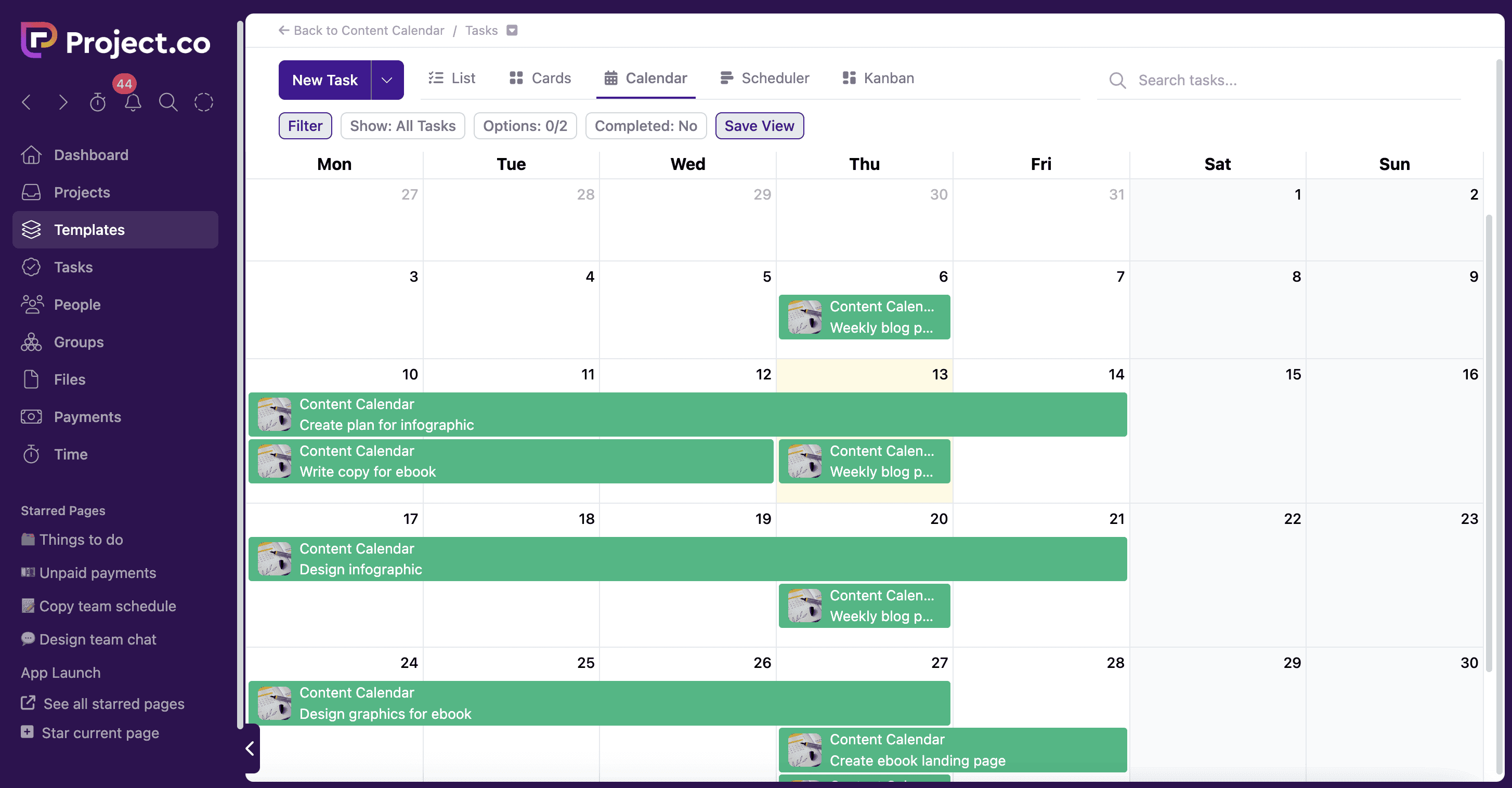
As you can see, for this month the content team plans to write an article every Tuesday, post on social media every Wednesday, and also create some eBook and video content.
Why a content calendar is important
In addition to the benefits outlined above, having a content calendar is important because it adds a level of organisation and consistency to your content marketing efforts. Consistency is super important for SEO purposes.
This could be due to the volume of articles published, but it could also be that consistently publishing great content sends a signal to search engines that your site is a reputable and regularly updated source of information.
The same applies for other content, too. If you’re posting video content to YouTube, it helps to post at the same time and day every week. Not only for search optimisation, but also for your viewers – this helps them to remember when your next video is going to be out and will hopefully lead to them coming back to your channel on those days to watch your latest video.
A content calendar will also help to reduce wasted time and effort on duplicating content you’ve already published, or working on content that doesn’t perform well.
You can prevent this by looking back over your content calendar to see what you’ve already published, what worked, and what didn’t.
And you can also use your calendar to look forward. If you have a lot of content creation planned in then you can prepare accordingly by freeing up resources in your team or hiring freelancers to cover your busy period.
How to create a content calendar that really works
1. Prepare
Step one is preparation. Before you can start creating content, you need to know what content your audience really wants from you.
You can do this by using keyword research tools to find out what your ideal customers are searching for.
A great free tool to use is Answer The Public. To get started, all you need to do is type in one of the keywords associated with your brand. Keeping with our cake analogy, we searched for “cupcakes”.

From here, you can see exactly what people are searching for when it comes to cupcakes and get some great ideas for content – whether that’s online guides, GIFs to post on social media, or podcast episodes.
After gathering ideas for new content, it’s also a great idea to do a ‘content audit’. By looking through your old content you can find out what isn’t performing and see if there’s anything you can do to improve it.
To do this, head to your blog and look at all of the posts on any given topic, let’s stick with cupcakes.
Then, take a look at those posts on GA4 to discover which ones are receiving the most traffic, and which are receiving the least. You can also factor in time-on-page, click-through-rates, and any other metrics you would like to track.
You can also see if there’s anything you can do to improve the content that is performing well – it couldn’t hurt!
One last thing that you should do to prepare is create a brand guidelines document. This can help you ensure that all of your content is consistent in quality and voice, across the board.
You don’t need to spend too much time on this, it could be as simple as a Dos & Don’ts list that you can share with your marketers. For example:
DO…
…include images and GIFs in blog articles
…start every podcast and video with “Hey all you cake lovers, bakers, and eaters!”
…use a first-person narrative in emails and social media posts
DON’T…
…use stock photography in any visual content
…write long paragraphs in blog articles (keep it to 4 sentences or less)
…let podcasts run longer than 60 minutes
2. Produce
Once you’ve gathered all of your content ideas, it’s time to begin mapping out your milestones on your content calendar.
If you don’t have a project management tool like Project.co, you could also do this on a simple calendar app, like Google Calendar. Google Calendar even has some cool designs that add a little bit of fun to your milestones:
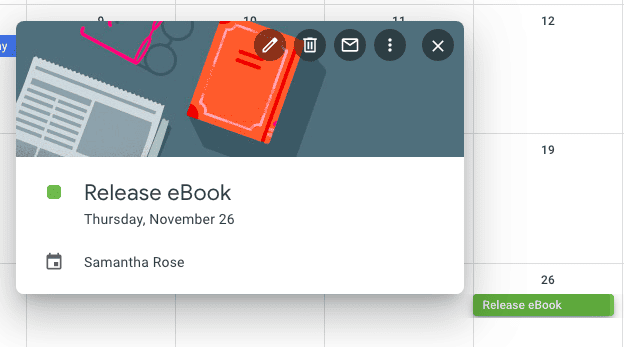
But a project management tool will give you so much more clarity and control.
If there’s one issue with the Google Calendar shown above, it’s that it looks pretty messy and overwhelming. With Project.co, you can create different calendars for different purposes, so that you’re not overwhelmed with tasks.
You can have one calendar for your social media posts:
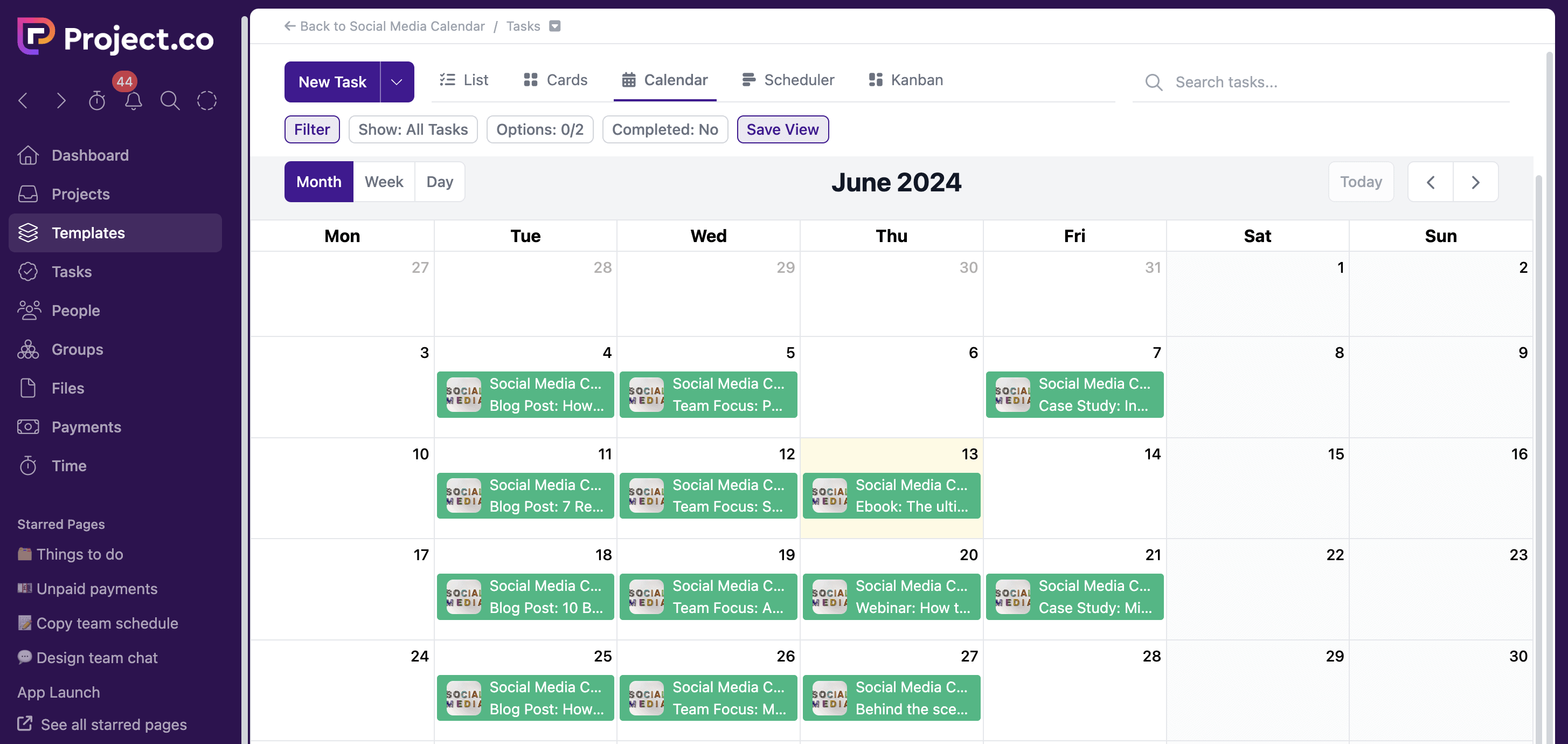
One for your podcast episodes:

And so on. Plus, with a project management tool, not only will you be able to add your tasks to the correct dates, you’ll also be able to assign these tasks to different team members, and update the statuses – so that everyone is clear on where your content marketing is up to!
As you produce your content, the content calendar can be updated in real-time. You can edit tasks from directly within the calendar. And also drag tasks onto new dates (if they’re taking longer than planned to complete).
Project.co also has a kanban view that can be used to manage tasks – from one stage to the next – in a visual way.

Once one part of the process is complete, you can easily drag and drop tasks onto the next stage!
3. Promote & Review
Publishing your content online should not be the last stop for your marketing efforts. To really get the most out of your content you need to promote it as much and as often as you can.
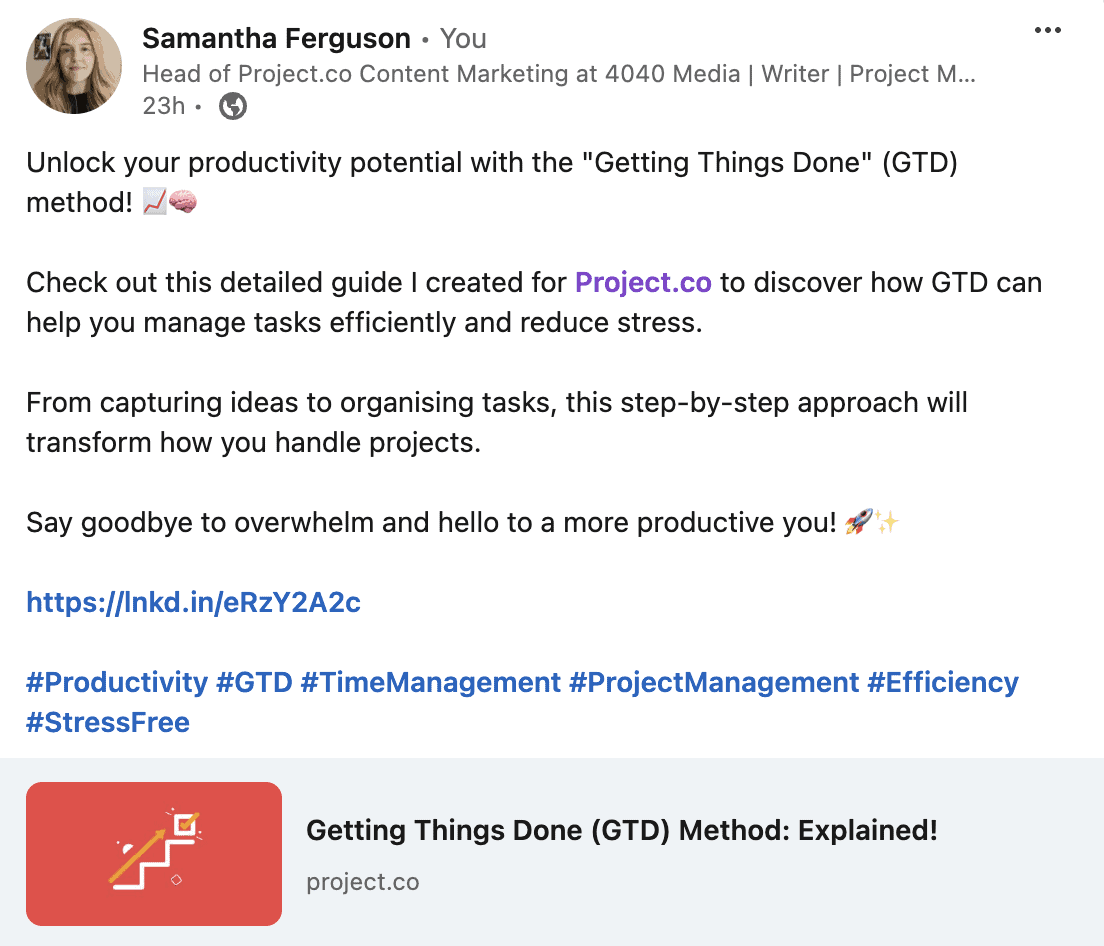
In addition to promotion, it’s important to review your content regularly – perhaps every quarter – to see what is generating traffic and leads and what isn’t.
You can then take the content that isn’t performing as well as you’d hoped and tweak and edit it to see if you can improve it. After all, you’ve spent a lot of time and effort on creating your content – it’s only right that you give it the post-publishing attention it needs to ensure you get as much eyes on it as possible.
One simple and effective way to do this is to search online for the keyword you’re trying to rank for, like so:
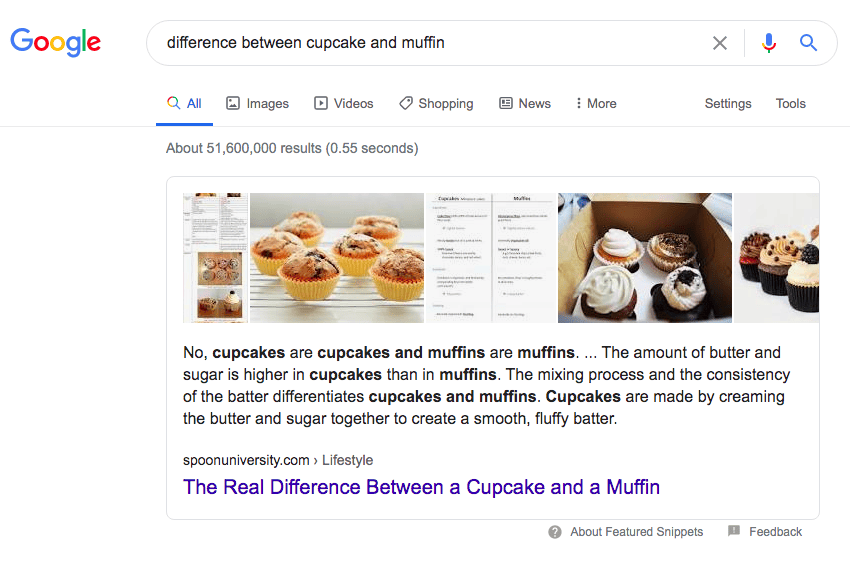
Then, review the content that appears at the top of the search page and compare that with your own.
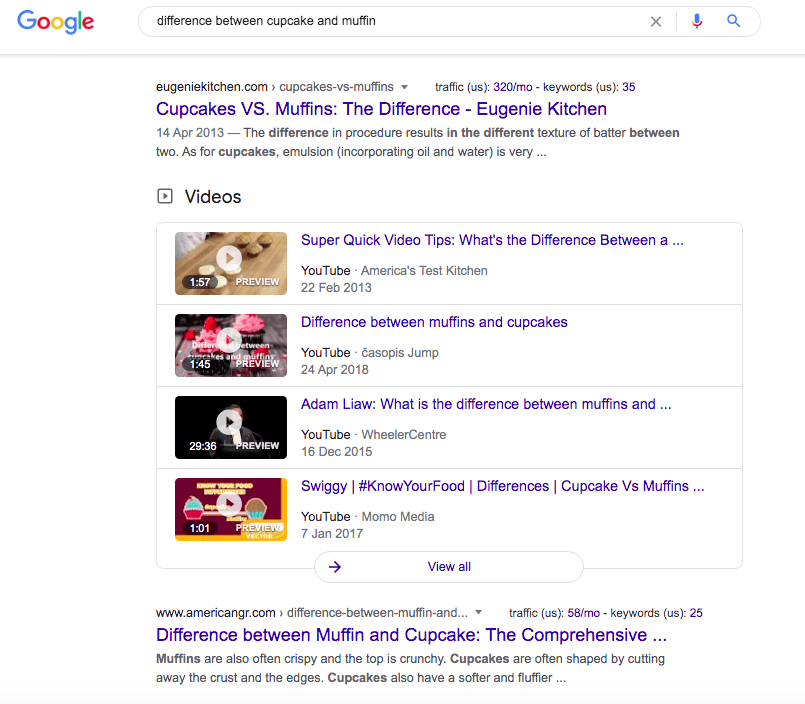
What does it have that you don’t have? How can you make your content better than the top result?
By doing this for every piece of content, you’ll give yourself a better chance of rising up the search engines and generating more traffic and leads with every piece of content you publish.
3 Benefits of content calendars
1. Spot and eliminate content gaps
Teams that don’t use a content calendar are likely just firing out content randomly, but this is not the best strategy.
Without monitoring the content you’re creating and publishing you could end up posting six articles in one week, and then neglect your blog while you work on an eBook for three months.
You may also find that you’re only writing about one of your products or solutions, and completely neglecting the rest.
2. Become aligned across departments
So, you’re creating content to generate leads. And your sales team will then take those leads and hopefully convert them into customers. That’s the goal.
But, when your sales team has no idea of the content you’re creating from one week to the next – because you have no idea of the content you’re creating – it can become difficult to nurture those leads.
A solid content calendar can really help to align your sales and marketing teams. For example, let’s say your company sells three different types of cakes: wedding cakes, cupcakes, and birthday cakes.
Your sales and marketing teams can get together and agree on a product to push for this quarter, e.g. wedding cakes. And then you could schedule this into your content calendar – so that all of your content focuses around the wedding cakes.
This will help bring in warmer leads to the sales team and make it easier to convert those leads into customers – which is exactly what we want from every piece of content!
3. Analyse and improve
Content calendars aren’t just great for looking forwards. They can also be used retrospectively.
It helps to look over your previous content calendars and monitor the performance of your content. For example, perhaps the view-time on the wedding tips video series you made was really impressive, but the video series about how to make wedding cakes lost viewers after a few seconds.
Similarly, maybe the article that compared different birthday cakes had a really high bounce-rate, but the one about the origins of birthday traditions pulled in a lot of new leads.
Content is a funny and fickle business – and you just never know what is going to resonate with people.
Final thoughts
According to our communication survey, 61% of people feel that the organisation in their business is only average or below.
This is alarming considering that organisation is so important for ensuring consistent success, across all aspects of your business – especially content marketing.
We hope the tips and tricks outlined in this article will help you get on top of your content, and be sure to check out our free content calendar to get started – make 2024 your year for content marketing!



